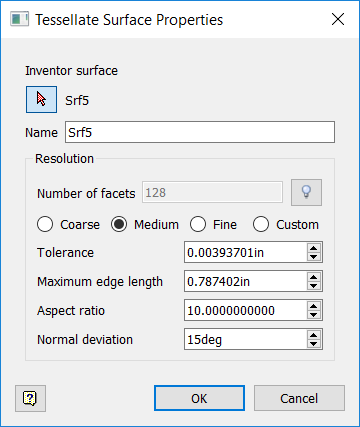Tessellation Dialog Box Reference

Inventor Surface
The surface being tessellated. You can use the selection arrow to select a difference surface in the model to replace the currently selected surface.
Number of Facets
A read-only box showing the number of facets (polygon edges) generated on the surface using the current tessellation settings in the dialog box.
Preview 
Show tessellation results in the application window.
Pre-sets
Set tessellation values to pre-determined levels that are always the same no matter the size of the surface.
- Coarse: Designed to favor performance over quality.
- Medium: Designed to balance performance and quality.
- Fine: Designed to favor quality over performance.
- Custom: Indicates that you have entered your own tessellation values in the dialog box.
Tolerance
The maximum distance that the facet can deviate from the smooth surface. Smaller values increase the number of facets and processing time.
Maximum Edge Length
The maximum edge length, in centimeters, of any triangle in the mesh. A value of zero means there is no maximum. Generally you should start with values between two and five.
Aspect Ratio
The maximum length-to-height ratio that a triangle can have. This helps to avoid long thin triangles. A value of zero means there is no maximum. Autodesk recommends starting with a value of four.
Normal Deviation
The maximum deviation between adjacent vertex normals; that is, the angle between normals. A value of zero means there is no maximum.
